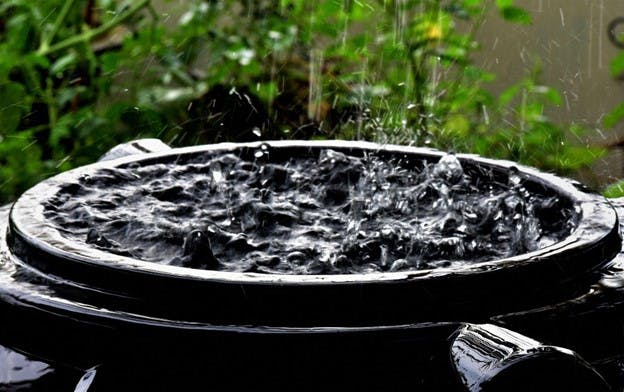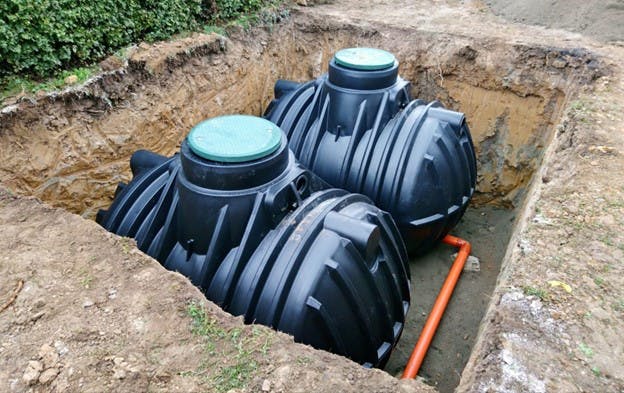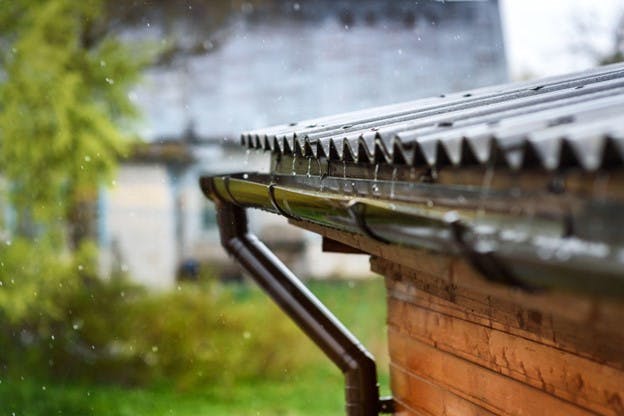February 2024
Sustainable Living: Rainwater Harvesting and Wastewater Reuse
Though water covers the majority of our planet, only about 2% of it is freshwater, and most of that is deep underground or frozen in glaciers and ice caps. As our global water consumption rises, we increasingly face water shortages from droughts and the impacts of climate change. Our water demand is outstripping the supply of our available water sources. That makes sustainable practices like rainwater harvesting and wastewater reuse more important than ever, offering alternatives to more energy-intensive solutions like desalination.
In this article we’re going to take a deep dive into these alternative water management systems to better understand how they work, when these methodologies are useful, and how they will continue to impact us all into the future.
What Is Rainwater Harvesting?
Rainwater harvesting is the practice of capturing rainwater from a catchment area, typically a roof, and storing it in rainwater tanks for later use. While you may not want to use this untreated rainwater as drinking water, non-potable water can be quite useful for watering plants, cleaning, toilet flushing, or even doing laundry.
Rainwater is usually captured using a catchment system consisting of gutters and downspouts that will direct rainwater into large storage tanks so it can be used at a time when it’s more needed. Rainwater collection systems not only help you save on your water bill but also enable you to efficiently utilize this natural resource as you need it rather than depending on mother nature’s unpredictable schedule.
As a sustainable practice, water harvesting reduces your reliance on traditional water supplies, minimizes the impact on local water resources, and can help mitigate the effects of droughts and water scarcity. By utilizing precipitation, you can tap into a renewable resource, conserving the more limited supplies of groundwater and surface water you’d normally need to rely on.
Before you set up a rainwater harvesting system, be sure to check state and local laws. Collecting rainwater may be illegal in certain locations.
Can I Drink Rainwater?
Drinking rainwater is possible, but its safety depends on several factors, including how it's collected, stored, and treated. Rainwater collected from roofs and stored properly can be relatively clean, but it may still contain pollutants from the atmosphere or the catchment surface.
To make rainwater safe for drinking, it typically needs to go through filtration and disinfection processes to remove any contaminants and pathogens. Rain water quality can vary from location to location. It’s best not to drink it without proper treatment.

What Is Wastewater Reuse?
Wastewater reuse involves capturing and sometimes treating wastewater from homes, businesses, and industries for reuse in other applications. Every day, tens of billions of gallons of water are used in American homes. This amount of water dramatically increases if you add in industry and business water use. That’s a lot of demand on our rivers, lakes, and underground aquifers, and a lot of strain on our water systems. This water recycling allows us to take some of that water that goes down our drains each day and reuse it with minimal treatment, if any.
Wastewater reuse can be done on many different scales. Municipalities often have treatment systems designed to treat minimally used water which is then used by parks, farms, and industry. This can also be done on a smaller scale by individuals. By diverting greywater to storage cisterns instead of letting it go to the sewer systems, it can be recycled. Greywater is water that’s been minimally used and will have low concentrations of contaminants. This can be water from bathtubs, washing machines, and sinks as opposed to something like toilet water which could be full of pathogens.
Greywater reuse systems can be great for water savings. You can use it for lawn care in drought-prone areas or this wastewater can be repurposed for flushing toilets.
What Are the Sustainability Benefits of Rainwater Harvesting and Wastewater Reuse?
Both rainwater harvesting and wastewater reuse offer significant benefits for the environment, your wallet, and your home. These sustainable practices help to protect wetlands and other aquatic environments by reducing reliance on traditional water sources, such as rivers and groundwater. They also lessen the demand on what might be otherwise aging and overburdened municipal water systems.
Rainwater harvesting captures and utilizes a natural resource instead of allowing it to become stormwater runoff that deposits pollution into rivers and lakes. Home wastewater reuse, on the other hand, is a wastewater management technique that reclaims barely used water that would otherwise be lost, repurposing it for non-potable uses like irrigation and flushing toilets.
Together, these two practices can mean significantly less water demand from unsustainable sources while allowing you significantly more freedom with your home water usage. It also means a cheaper water bill, less stress on infrastructure, and less pollution-filled runoff and wastewater entering sensitive natural environments.

What Are the Components of a Rainwater Harvesting System?
There are many possible ways to set up a rainwater harvesting system but to make these stormwater management systems effective, they all need some form of the following stages:
- Catchment area: This is typically the roof of a building, where rainwater collects before being redirected through gutters, downspouts, and pipes.
- Gutters and downspouts: These channel the water from the roof or capture area to the rain barrel or other storage area.
- First flush diverter: When it starts to rain, there is likely to be a lot of debris from your roof in the rainwater. This diverts an amount of water and solid debris away from your storage tanks so you only capture clean water.
- Filtration system: Before storage, the water is often filtered to remove debris and contaminants that could damage your water quality.
- Storage tanks: The filtered water is then stored in tanks for later use. These tanks can be above or below ground.
- Distribution system: Finally, a system of pumps and pipes can deliver your stored water for various uses, depending on the level of treatment it has undergone.
Each component plays an important role in capturing useful rainwater and transporting it to where you need it.
What Are the Components of a Wastewater Reuse System?
To make it feasible to capture and reuse greywater, a wastewater reuse system you might use at home or business would typically involves these components:
- Collection system: This gathers wastewater from various sources such as household or industrial drains and sends it to be stored or to be treated.
- Preliminary treatment: If there’s a treatment system, this is where large solids and debris would be removed with screens or settling tanks.
- Secondary treatment: In more advanced systems, further filtration with activated carbon filters and disinfection using UV light or chlorine to purify the water for specific non-potable applications could occur.
- Storage: Large tanks store the collected and treated water until it's needed. Distribution system: A network of pipes and pumps delivers the treated water for whatever you need it for.
Every component plays a part in making sure that the reused water is safe and effective for its intended use.
What Regulations Govern Rainwater and Wastewater Reuse?
Regulations on rainwater harvesting and wastewater reuse vary by state, and mostly focus on public health, environmental protection, and water rights. For rainwater harvesting, rules may include permitted collection surfaces, treatment standards, how much water you can collect, and where that water can be used.
In Colorado, for example, residential properties can use rain barrels with specific capacity limits. Utah allows rainwater collection, but it requires registration, limits storage capacity, and only allows you to use the water on the property it was collected on. On the other hand, some states give tax incentives or even require some new constructions to have rainwater capturing systems.
Wastewater reuse regulations usually address treatment and safety standards, especially for greywater systems, to ensure its safe recycling for irrigation or industrial use. This helps avoid unnecessary pollution in the environment.
Before setting up any type of water recycling or capturing system, make sure you consult your local laws. Following these regulations can help keep you safe and out of trouble.

What Are Common Applications for Harvested Rainwater and Treated Wastewater?
Harvested rainwater and treated wastewater have a wide range of applications in both residential and commercial settings.
Rainwater
Here are a few of the top uses for captured rainwater.
- Irrigation: Rainwater is ideal for watering gardens, lawns, and agricultural lands.
- Toilet flushing: Toilets waste a significant amount of potable water in households.
- Laundry: Using rainwater to wash your clothes can save hundreds of gallons of water per month, and the wastewater may be reusable.
- Car washing and general cleaning: A great use of non-potable water.
Treated Wastewater and Greywater
Treated wastewater has many uses both in your home and in larger community settings. Here are a few helpful ways wastewater is being reused.
- Landscape irrigation: Safe for plants, it's an excellent way to conserve potable water.
- Industrial processes: It can be used for cooling, manufacturing, and cleaning needs.
- Fire protection: Stored treated wastewater can be a resource to put out fires.
- Replenishing aquifers: In some cases, treated wastewater can help recharge groundwater.
Both these sustainable water sources reduce the demand on traditional water supply systems and are important parts of a balanced water management system.
Are There Incentives for Harvesting Rainwater and Reusing Wastewater?
Different states have different rules regarding water recycling practices. While some states may have restrictions, many others actively encourage the use of rainwater harvesting and wastewater reuse through various incentives and rebates.
These incentives can include tax credits, reduced water utility rates, or even grants for installing such systems. Additionally, local governments often provide resources and support to help residents and businesses implement these sustainable water solutions. Before installing a harvesting system in your home or business, be sure to check local regulations so you get the maximum financial benefit available.
What Are the Downsides of Rainwater Harvesting and Wastewater Reuse Systems?
While rainwater harvesting and wastewater reuse systems offer many environmental and economic benefits, they also come with certain challenges that should be considered.
Cost of Installation
One of the primary barriers is the initial cost. Installing a rainwater harvesting system or a greywater reuse system can be expensive. Costs include purchasing storage tanks, filtration and treatment equipment, and possibly modifying plumbing systems.
Maintenance Requirements
These systems require regular maintenance to ensure they function efficiently and safely. This includes filter maintenance, treating water to prevent contamination, and inspecting and repairing components.
Limited Supply and Reliability
Rainwater harvesting depends on rainfall, which can be unpredictable. Similarly, the volume of greywater generated may not always meet the demand for its intended reuse.
Quality Control
Ensuring the water quality, particularly for rainwater, can be challenging. Rainwater may collect pollutants from the atmosphere or the catchment surface, necessitating thorough filtration and treatment.
Regulatory and Health Concerns
There are often strict regulations governing the installation and use of these systems, especially when the water is intended for indoor use. Mismanagement can pose health risks, particularly if greywater is not adequately treated.
Space Requirements
Installing large storage tanks for water can be space-consuming, which might be a constraint in urban settings.

Should You Capture and Recycle Water?
There are a lot of benefits to rainwater harvesting and wastewater reuse for both the environment and your household. However, there’s a lot to consider, like local laws, safety, and the cost and feasibility of setting up and maintaining these systems.
No matter how you choose to get your water, make sure it’s protected with a HomeWater filter. HomeWater's UPSTREAM 4-Stage Whole Home Water Filters can improve your water quality by removing impurities like sediment, chloramines, DPBs, PFAS, microplastics, heavy metals like chromium, and more. Our American-made whole house and under-counter water filters make every glass of water clean and delicious right from your faucet.
You’ll taste the difference with HomeWater.